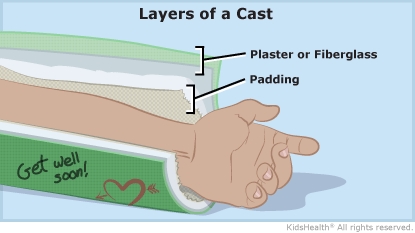Helping Your Child Care for a Cast
Help your child take care of the cast so it stays in good condition and doesn't irritate the skin.


General cast care:
-
To help prevent swelling in the first few days after the cast is put on:
-
Keep food, dirt, sand, lotion, and powder away from the cast.
-
If given a sling or crutches, your child should use them as directed.
Problems to watch for:
-
Swelling: If the fingers or toes get swollen, have your child raise them above heart level for up to an hour.
-
Sharp cast edges: If the skin near or under the cast gets red or irritated, put tape or moleskin (available at drugstores) on the edge of the cast.
-
Itching: Don't let your child scratch or put anything into the cast for itching. Instead, tap lightly on the cast or use a hair dryer on the cool setting to blow air in and around the edges.
Be sure to:
-
Follow up with the orthopedic specialist as recommended.
-
Ask the orthopedic specialist if your child needs to avoid gym, sports, or any other activities.
If Your Child Has a Non-Waterproof Cast
Keep the cast dry:
-
No swimming or putting the cast under water (even if it is covered with plastic).
-
Give younger kids sponge baths. To give a sponge bath, use a wet sponge or washcloth to wash and rinse your child. Avoid getting the cast wet.
-
Older kids can take baths. Baths are better than showers because it is easier to keep the cast dry in a bath. There are several ways to cover the cast while bathing. You can:
-
Cover the cast with two plastic bags. First, put one bag on and seal the top with a rubber band (or tape). Then, put the second bag on and seal it with another rubber band (or tape).
-
Cover the cast with 1–2 layers of plastic wrap and then a plastic bag that is sealed at the top with a rubber band (or tape).
-
Use a waterproof plastic cast protector. You can buy these online or at most drugstores without a prescription.
After you cover the cast, be sure to also keep it completely out of the water by propping it up on the side of the tub.
If the cast or liner gets splashed, gently blow air into it from a hair dryer on the cool or fan-only setting.
If Your Child Has a Waterproof Cast
Your child can swim and bathe without covering the waterproof cast.
Once a day, and after bathing or swimming:

Your child:
-
has redness or irritation under or near the edges of the cast
-
has new or worsening pain
-
can't move the fingers or toes freely
-
has numbness or tingling of the fingers or toes
-
has pale or blue fingers or toes
-
has swelling of the fingers or toes that doesn't go down after raising them above heart level for up to an hour
The cast:
-
gets damaged, or the lining gets damaged
-
feels too tight or very loose
-
has something stuck inside it, such as a piece of food or a small toy
-
gives off a bad smell or fluid leaks from under it
-
gets wet (in a cast that is not waterproof)

What can happen if a cast gets wet? If a cast or liner that is not waterproof gets wet, it can lead to a skin rash or infection. It can also make some types of casts break down.
How are casts removed? Orthopedic specialists take off casts with a small electrical saw. The saw cuts through the cast material but stops before it touches the skin.
When the cast first comes off, the skin usually looks pale, dry, or flaky and the muscles look smaller. This is normal and goes away within a few weeks.